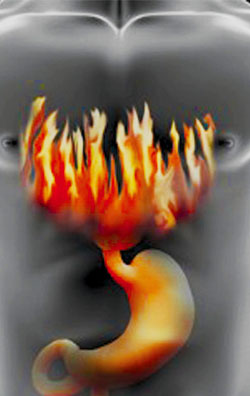
Gastroesophageal reflux diseases also known as GERD is a medical condition characterized by backflow of stomach acid or stomach content in the food pipe (esophagus). Following reflux from stomach the lining mucosa of the esophagus gets damaged and leads to symptoms of GERD. This condition is quite common worldwide however in the Western countries about 10-20% of the population are affected.
The most common presenting symptom of GERD is heartburn; whenever heartburn or acid reflux interferes with daily activity or occurs at least two times every week GERD is suspected. In most of the cases change in the life style pattern as well as intake of certain drugs are sufficient to control the symptoms of GERD. However some may need surgery to control the symptoms.
Symptoms
Common symptoms include heartburn characterized by burning sensation in the chest area usually spreading to throat and sour taste in the mouth, pain in the chest, painful swallowing (dysphagia), dry cough, pin in the neck, acid reflux characterized by food regurgitation, sensing painful lump in the throat area etc.
Prolonged GERD may lead to number of complications like
- Narrowing of the canal of the esophagus especially in the lower part (stricture): chronic exposure of the lining cells of the esophagus to stomach acid lead to scar tissue formation which eventually lead to contraction of the esophageal tube and the different symptoms of GERD like painful and difficult swallowing
- Esophageal ulceration: contact with stomach acid may lead to severe damage (erosion) to the cells of the lower esophagus and ulcer formation. This type of ulcer may lead to bleeding, pain during swallowing etc.
- Barrett’s esophagus: longstanding GERD may lead to precancerous change in the damaged lower esophageal cells known as Barrett’s esophagus which requires regular follow up with endoscopy.
Causes
Under normal circumstances after swallowing the stomach contents are prevented from entering the esophagus by the sphincter located at the lower end of the esophagus while opening of this sphincter during swallowing facilitates entry of food from esophagus to stomach.
In GERD patients this valve is weakened and remains open even after swallowing allowing entry of food from stomach to esophagus. Chronic contact of the esophageal cells to the corrosive stomach acid leads to erosion of the mucosal lining (ulcer), bleeding, scar tissue formation leading to permanent narrowing of the esophagus and ultimately Barrett’s esophagus.
Risk factors
Common risk factors associated with GERD include obesity as studies have shown that change in body mass index (BMI) is responsible for about 13% changes associated with GERD, protrusion of stomach through the diaphragm (Hiatus hernia), pregnancy, chronic smoking, Asthma, diabetes, connective tissue disease like scleroderma etc.
Treatment
Initially over the counter available acid controlling drugs are prescribed. These include acid production reducing drugs H2 blockers like ranitidine, famotidine, proton pump inhibitors like omeprazole, acid neutralizing antacids like sodium bicarbonate, aluminium hydroxide etc.
Sometimes surgery is required to control the disease; these include
- Linx is a device to increase the constricting capacity of lower esophageal sphincte
- Nissan fundoplication to reinforce the capacity of the sphincter.





